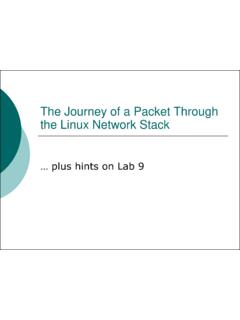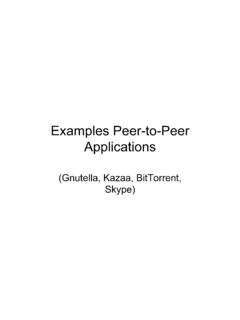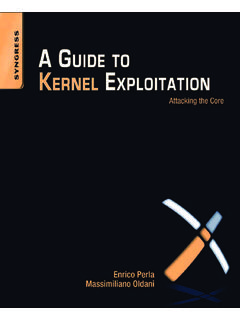Transcription of Detecting kernel rootkits - Dartmouth Computer Science
1 Detecting kernel rootkitsAshwin RamaswamyDepartment of Computer ScienceDartmouth CollegeMasters Thesis ProposalDartmouth Computer Science Technical Report TR2008-627 Proposal Presentation Date: 2 September, 2008 AbstractKernel rootkits are a special category of malware that are deployed directly in thekernel and hence have unmitigated reign over the functionalities of the kernel seek to detect such rootkits that are deployed in the real world by first observinghow the majority of kernel rootkits operate. To this end, comparable to how rootkitsfunction in the real world, we write our own kernel rootkit that manipulates the networkdriver, thus giving us control over all packets sent into the then implement a mechanism to thwart the attacks of such rootkits by noticingthat a large number of the rootkits deployed today rely heavily on the redirection offunction pointers within the kernel .
2 By overwriting the desired function pointer to itsown function, a rootkit can perform a goal is not just the detection of kernel rootkits , but also to levy as little animpact on system performance as possible. Hence our technique is to leverage existingkernel functionalities (in the case of Linux) such as kprobes to identify potential attackscenarios fromwithinthe sytem rather than from outside it (such as aVMM). We hopeto introduce real-world security in devices where performance and resource constraintsare tantamount to security IntroductionA looming threat of malware is not an unfamiliar observation in the modern world. Mal-ware threats are steadily venturing into diverse and intricate territories such as obfuscated1packing, local/global environment awareness, and command-driven scalable sustained exposure to the Internet, a majority of systems are now, more than ever,vulnerable to deceptive software; either downloaded manually or injected surreptitiously intothe system.
3 In this thesis, we focus on a particular subdomain of malware called termrootkitoriginates from the composition of the individual termsroot, referring tothe highest privilege of access that can be obtained in a traditional Unix-based operatingsystem, andkit, referring to a set of programs that are designed to exploit a target system,gain root access and then maintain it without tripping any alarms. rootkits are no longeran emerging threat. Their establishment in current systems is ubiquitous, and their presenceis undeniable in any modern system infected with malware. rootkits differ in a few waysfrom other malware such as viruses or worms. For one, they do not propagate viciously;in fact they almost never clone themselves. rootkits assume that the system has alreadybeen rooted1, and therefore their objectives are fundamentally different from viruses orworms, whose goals are to first break into a target system by exploiting its weaknesses andvulnerabilities.
4 By contrast, a rootkit aims tomaintainprivileged access without alertingthe user or system administrator. This challenge necessitates a different set of priorities forthe rootkit program. kernel or application vulnerabilities no longer matter for the rootkitauthor, who instead searches for sly, beguiling tricks to play on the operating system thatwould allow him to remain inconspicuous within the remote machine after rooting , rootkits can be divided into two categories:1. User-level2. kernel -levelUser-level rootkits are programs that overwrite the filesystem binaries and libraries withcustomized versions that accomplish the desired hiding goals. Programs such asls,ps,netstatare some common binaries that are likely to be modified to hide the rootkit and itsaccomplices from an unsuspecting user. In addition, a user-space rootkit might also modifyconfiguration files and scripts in order to guarantee persistence and remain incognito.
5 Theprevailing weakness of such malware is that there exist standard techniques to easily detect,prevent and take corrective action against these rootkits . Software such as Tripwire [5]and AIDE [1] have proven themselves to be effective in most cases. Moreover, user-spacerootkits, with limited manoeuvreability, are unable to surpass these detection techniqueswithout stepping into the kernel itself, which leads us to the second a hackish term for gaining unauthorized root privileges on a remote rootkits are more intricate and progressive than their user-space counter-parts. With techniques ranging from na ve redirection of system-calls and altering interrupthandlers to modifying scheduler lists andVFSredirection, kernel rootkits are gaining tremen-dous momentum as the rootkit authors aspire to sustain their attacks and elude detectioneven from paranoid system adminstrators.
6 There exist numerous techniques for a rootkitto enter the kernel . In Unix-based systems, rootkits typically employ the loadable kernelmodule (LKM) interface to insert their code into the kernel . Another avenue of attack isthrough the/dev/memand/dev/kmemdevices that allow direct memory access to systemmemory. windows rootkits usually utilize the Direct kernel Object Manipulation (DKOM)technique to modify kernel objects that control a variety of kernel behavior such as processmanagement, network management etc. In this thesis, we focus only on Linux rootkits , butthe underlying techniques remain universal and hence can be utilized for similar detectionmechanisms in other operating system kernels such as Solaris, Mach, windows has also emerged a relatively new breed of rootkits called hypervisor rootkits [27],which exploit the virtualization layer to accomodate themselvesbelowthe operating systemitself, and thereby gain total control over the entire system.
7 Such rootkits are expectedto faithfully duplicate the underlying hardware under all circumstances. However, faithfulreplication of hardware is believed to be hard and error-prone [12] due to various anomaliesand discrepancies that can be caught at the CPU, MMU, TLB, timer chips etc. This istroublesome for the rootkit since now it has to not only duplicate the hardware, but also allthe hardware s faults and anomalies just to avoid detection from the exist other categorizations for rootkits , focusing more on their attack strategiesrather than their domain of deployment. Rutkowska [26] presents a malware taxonomydescribing four classes of malware ranging from Type0to TypeIIIof increasing threat-levels. Type 0 Malware includes just applications that areharmfulto the system, but whichdo not subvert the operating system in any way.
8 An example of such malware would be aprogram that deletes all files on disk. Type I Malware modifies resources in the system thatwere designed to be constant, such as the system-call table, kernel code sections etc. Type IIMalware modifies the dynamic resources in the system, such as kernel data section, functionpointers, data structures etc. Finally, Type III Malware comprise of hypervisor et al. [8] focus on the attack vectors of kernel rootkits , categorizing them into: Control Hijacking Control Interception3 Control Tapping Data Value Manipulation Inconsistent Data StructuresIn this thesis, we primarily focus on TypeIIrootkits employing Control Interception andControl Tapping Motivating ScenarioBroadly speaking, anomaly-based intrusion detection is an expensive process. While im-plementing an IDS, one has to be prudent to not adversely affect the performance of theoperating system itself.
9 Anomaly detection, by its very nature, searches for the presenceof abberant behavior either within application processes or within the kernel . Performanceconsequences in the former might still be grudgingly accepted since only the monitored pro-cess(es) are being affected, but similar performance impacts on the kernel can escalate, effec-tively crippling all applications (including network-facing services) running on the , one has to be extremely cautious when deploying an IDS in a real world scenario, tonot only take into consideration the guarantee of security that the IDS provides, but also thereal-time impact the IDS software might have on the normal functioning of the established that ensuring kernel integrity from rootkits is a vital challenge today, weobserve that a large number of anomaly-based rootkit detectors are backed by virtual machine(VM) technology.
10 While VMMs are generally thought to be a safe haven for monitoringsoftware (since malicious software in the guest is assumed to be incapable of escaping intothe host), hardware-assisted virtual machine technology for fully virtualized guests impactssystem performance either to a lesser or greater extent, depending on one s point of view,and the actual tests conducted on the VMs. But the average performance hit was about6% for Vmware and 15% for Xen. Vmware s report [28] has detailed analysis on the latencydelays for both the Vmware ESX Server and Xen hypervisor. In the embedded domain,it would be unpropitious to deploy these systems because of limited resources, performanceconstraints and real-time requirements, specifically within the US power grid in some of these systems seems to be lacking, as evidenced in the recent work doneby our colleagues in attacking networked set-top boxes widely deployed across campus [6].

















